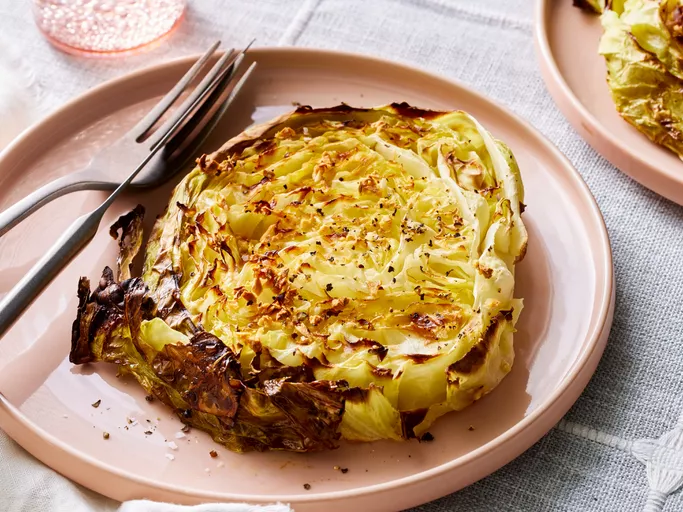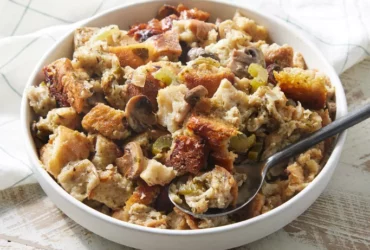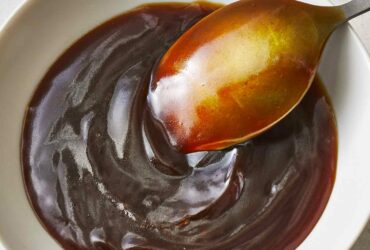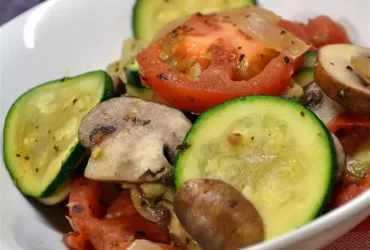Ingredients
Essential
Cabbage steaks are a delicious and healthy dish that can be enjoyed as a side or main course. The essential ingredients for this recipe are:
- Cabbage – This is the star ingredient of our dish, and we will need about 1 large head of cabbage. You can use either green or red cabbage for this recipe.
- Caraway seeds – These seeds have a distinctive flavor that complements the earthy taste of cabbage. Use about 2 teaspoons of caraway seeds for this recipe.
- Olive oil – We will need some olive oil to cook the cabbage steaks, so make sure you have enough on hand. Use about 2 tablespoons of olive oil.
- Garlic – Garlic adds a pungent flavor to our dish that pairs well with cabbage. Use about 3 cloves of garlic for this recipe.
- Onion powder – This is an optional ingredient, but it can add depth to the flavor of our dish. Use about 1 teaspoon of onion powder.
Other ingredients that you may want to consider adding to your cabbage steaks recipe include:
- Salt – This is a must-have for any savory dish, and we will need about 1 teaspoon of salt.
- Black pepper – Like salt, black pepper is essential to add flavor to our dish. Use about 1/2 teaspoon of black pepper.
- Paprika – This spice adds a smoky flavor that complements the earthy taste of cabbage. Use about 1 teaspoon of paprika.
Some optional ingredients you can consider adding to your recipe include:
- Bacon bits – These add a smoky flavor and crunchy texture that pairs well with cabbage. Use about 2 tablespoons of bacon bits.
- Cheddar cheese – This can be grated over the top of our dish for an extra burst of flavor and creaminess. Use about 1/4 cup of cheddar cheese.
Remember, these are just suggestions, and you can customize your recipe to suit your tastes and dietary preferences.
Cabbage
- Cabbage, a cruciferous vegetable, is one of the key ingredients in many cuisines around the world.
- There are several varieties of cabbage, each with its own unique characteristics and flavor profiles.
- The most commonly used type in cooking is the green cabbage, which has dense, compact leaves with a slightly bitter taste.
- Other popular types include red cabbage, savoy cabbage, and napa cabbage.
In terms of nutritional value, cabbage is an excellent source of vitamins C and K, as well as fiber and antioxidants.
The key nutrients found in cabbage include:
- Vitamin C: important for immune function and collagen production
- Vitamin K: essential for blood clotting and bone health
- Fiber: helps with digestion and satiety
- Antioxidants: protect against cell damage and inflammation
Cabbage can be prepared in a variety of ways, including steaming, sautéing, boiling, and pickling.
For the Cabbage Steaks Recipe, you’ll want to choose a firm head of cabbage with tight leaves.
This will help the cabbage hold its shape during cooking and make it easier to slice into thin “steaks”.
Before using the cabbage in your recipe, be sure to wash and dry it thoroughly to remove any dirt or debris.
Cabbage pairs well with a variety of flavors, including garlic, ginger, lemon juice, and spices like cumin and coriander.
Onion
The onion, a fundamental component of the Cabbage Steaks Recipe, serves multiple purposes beyond adding flavor. It enhances the texture and presentation of the dish, contributing to its overall visual appeal.
Carefully selected for this recipe are yellow onions or white onions, which are preferred due to their mild sweetness and crunchy texture when cooked. These varieties do not overpower the delicate flavor of cabbage but add depth without dominating it.
The cooking process is crucial in transforming the raw onion into a tender yet still slightly firm element that complements the cabbage perfectly. By slowly sautéing the onions, they release their natural sweetness and develop an irresistible fragrance that elevates the dish to a whole new level of culinary excellence.
While some may opt for caramelizing the onions for added depth of flavor, in this specific recipe, a simple sautéing technique is sufficient. This approach not only preserves the onion’s texture but also allows its subtle sweetness to blend harmoniously with the cabbage’s slightly bitter taste.
The onion, whether raw or cooked, plays an integral role in balancing the flavors within the dish. Its pungency and slight bitterness counterbalance the sweetness of the cabbage, creating a delightful harmony of tastes that makes each bite a culinary experience.
Garlic
In the realm of culinary delights, few ingredients bring as much flavor and aroma to a dish as garlic. Its pungent and savory qualities make it an essential component in many recipes, including the esteemed Cabbage Steaks Recipe. As we delve into the world of garlic, let’s explore its various forms, nutritional benefits, and ways to incorporate it into our cooking.
Garlic is a type of bulbous vegetable that belongs to the Allium family, which also includes onions and leeks. It’s composed of multiple cloves, each containing a cluster of tiny bulbs surrounded by a papery skin. These cloves are typically white or purple in color and have a characteristic shape.
Garlic is an excellent source of nutrients, including:
- Vitamins C and B6
- Fiber
- Manganese
- Phosphorus
In addition to its nutritional benefits, garlic has been linked to various health advantages. Some of these include:
- Reducing cholesterol levels and blood pressure
- Aiding in the prevention of certain cancers
- Serving as an antimicrobial agent against bacteria and fungi
To incorporate garlic into your Cabbage Steaks Recipe, you can use it in a variety of ways:
- Minced Garlic: Simply mince the cloves using a chef’s knife or garlic press and add them to the pan when sautéing the cabbage.
- Garlic Oil: Mix minced garlic with oil and let it infuse for a few hours before adding it to the dish.
- Roasted Garlic: Roast whole cloves in the oven until soft and mashed, then add them to the recipe.
- In conclusion, garlic is an incredible ingredient that adds depth and flavor to any dish, including the Cabbage Steaks Recipe. Its nutritional benefits, versatility, and health advantages make it a must-have in every kitchen.
Olive oil
Olive oil plays a crucial role in this Cabbage Steaks Recipe. It serves as both a flavor enhancer and a cooking medium, allowing for the perfect balance of crispy exterior and tender interior.
When it comes to selecting an olive oil for this recipe, it’s essential to choose a high-quality option that is suitable for high-heat cooking. Look for an extra virgin olive oil with a peppery or fruity flavor profile, as these will add depth and complexity to the dish.
The Smoke Point of the olive oil is also an important factor to consider. A higher smoke point indicates that the oil can be heated to a higher temperature without breaking down or smoking. This ensures that the cabbage steaks are cooked evenly and that the oil’s nutritional properties remain intact.
When using olive oil in this recipe, it’s best to use it sparingly. A small amount will go a long way in adding flavor and moisture to the cabbage. Excessive use of olive oil can lead to an overpowering flavor and a greasy texture that detracts from the overall quality of the dish.
Some popular alternatives to olive oil, such as coconut oil or avocado oil, may also be used in this recipe. However, their distinct flavor profiles will alter the taste and aroma of the cabbage steaks. For example, coconut oil has a strong buttery flavor that may complement or clash with the other ingredients, depending on personal preference.
Ultimately, the choice of olive oil depends on individual taste preferences and dietary requirements. When used in moderation and paired with complementary flavors, it can elevate this Cabbage Steaks Recipe to a new level of culinary excellence.
Salt
Salt is a fundamental ingredient in many cuisines, including the recipe for cabbage steaks. It serves multiple purposes beyond just adding flavor to the dish.
The primary function of salt in cooking is to enhance the natural flavors of the ingredients. Salt helps to bring out the sweetness in vegetables like cabbage by balancing their inherent bitterness and acidity levels.
However, it’s worth noting that using too much salt can be detrimental to the taste and texture of your cabbage steaks. Excessive salt can result in an overly salty flavor profile that might overpower the other ingredients in the recipe.
In contrast, adding the right amount of salt can elevate the overall taste experience by allowing each component of the dish to shine through without any one flavor dominating the others.
Additionally, salt plays a crucial role in maintaining the structural integrity and texture of cabbage steaks. Salt helps to firm up the cell walls within the vegetable cells, which prevents them from becoming too soft or mushy during cooking.
This process is especially important when using high heat or prolonged cooking methods, as it can help preserve the crispiness and freshness of your cabbage steak even after cooking.
When selecting a type of salt to use in this recipe, consider opting for flaky sea salt or kosher salt. These varieties tend to be less processed and contain fewer additives than other types of salt, resulting in a cleaner taste that complements the flavors within your cabbage steaks more naturally.
Ultimately, mastering the use of salt is essential to creating an exceptional dish like cabbage steaks. By striking the right balance between seasoning with salt and maintaining its purpose as a flavor enhancer, you can achieve unparalleled results in this recipe.
Black pepper
Cabbage steaks are a delicious and healthy dish that can be made with just a few ingredients, including fresh cabbage, olive oil, salt, black pepper, and any other seasonings you like.
In this recipe, we’ll be using black pepper as one of the key ingredients to add flavor and depth to our cabbage steaks. Black pepper is a staple spice in many cuisines around the world, known for its warm, slightly sweet, and pungent flavor.
Here’s what you need to know about black pepper:
- Name: Piper nigrum
- Also known as: Black peppercorns, peppercorns, or simply pepper
- Description: Small, dark brown, elongated seeds with a smooth surface and a distinctive aroma
- Taste: Sharp, pungent, slightly sweet, and warm
- Aroma: Distinctive, sharp, and pungent
- Culinary uses: Used to add flavor and heat to dishes, particularly in savory and spicy recipes
- Health benefits: May aid digestion, reduce inflammation, and improve circulation due to its antioxidant properties
To use black pepper in our cabbage steaks recipe, we’ll simply sprinkle it over the cabbage before serving. The key is to use a generous amount, as this will allow the flavor to really come through.
Here’s why you should use high-quality black peppercorns:
- Flavor: Freshly ground black pepper has a more complex and intense flavor than pre-ground pepper
- Aroma: The aroma of freshly ground black pepper is more pungent and aromatic
By using high-quality black peppercorns and grinding them fresh just before use, we can ensure that our cabbage steaks have a bold, full-bodied flavor that’s sure to impress.
Instructions
Cooking
Cooking can be an intricate process that requires attention to detail and a clear understanding of instructions. This is particularly true when working with delicate ingredients, such as cabbage, where a single misstep can ruin the entire dish.
When it comes to preparing a Cabbage Steaks Recipe, there are several key steps to follow in order to achieve perfect results:
- Selecting the right type of cabbage is crucial. Look for a head of green or red cabbage that has compact, dense leaves with minimal signs of wilting.
- Wash and dry the cabbage thoroughly before cutting it into steaks. This will help remove any dirt, bacteria, or other contaminants that may be present.
- Cut the cabbage in half lengthwise and then slice each half into 1/2-inch thick “steaks.” The number of steaks you get will depend on the size of your cabbage head.
- In a large bowl, whisk together olive oil, salt, pepper, garlic powder, and any other desired seasonings. Add the cabbage steaks to the bowl and toss until they are evenly coated with the marinade.
- Let the cabbage steaks marinate for at least 30 minutes, or up to several hours in the refrigerator. This will allow the flavors to penetrate deep into the leaves and make them tender and juicy.
- Preheat a large skillet or sauté pan over medium-high heat. Remove the cabbage steaks from the marinade and add them to the pan, leaving some space between each steak for even cooking.
- Cook the cabbage steaks for 3-4 minutes on each side, or until they are tender and slightly charred. Repeat with any remaining steaks.
- Remove the cabbage steaks from the pan and serve them hot, garnished with chopped fresh herbs such as parsley or thyme if desired. You can also add a squeeze of lemon juice for extra flavor.
The key to achieving perfect Cabbage Steaks is to cook them just until they are tender, without overcooking or burning the leaves. This will help preserve their crunch and texture while still allowing them to absorb all the flavors from the marinade.
Heat the olive oil in a large skillet over mediumhigh heat.
To create the perfect Cabbage Steaks, it’s crucial to start with a well-planned cooking technique, and that begins with heating the olive oil in a large skillet. Place the skillet over medium-high heat.
This step is essential as it allows the oil to reach its optimal temperature for searing the cabbage steaks. The high heat also helps to create a nice caramelization on the surface of the cabbage, which adds depth and richness to the dish.
Once the skillet is hot, carefully place each cabbage steak into the pan, leaving about 1-2 inches of space between each slice. You want to make sure they have enough room to cook evenly without overcrowding the skillet.
As the cabbage steaks start to sear and develop a nice brown color, use a tongs or spatula to gently flip them over and continue cooking for another 2-3 minutes on the other side. Repeat this process until both sides are nicely caramelized.
Throughout the cooking process, maintain a moderate to high heat, adjusting as needed to prevent burning or charring. This step is critical in achieving that perfect balance of crunch and tenderness that characterizes the cabbage steaks recipe.
Add sliced cabbage and cook until slightly tender, stirring occasionally.
To successfully prepare delicious Cabbage Steaks, it’s essential to follow a series of steps that ensure the cabbage is cooked to perfection. The following instructions will guide you through this process.
Preparation
Begin by selecting a fresh head of cabbage and removing any damaged or wilted leaves. Rinse the cabbage under cold water to remove any dirt or debris, and gently pat it dry with paper towels to prevent excess moisture from affecting the cooking process.
Cutting the Cabbage into Steaks
Using a sharp knife, carefully cut the cabbage head into thick steaks. The ideal thickness will depend on your personal preference for tenderness and presentation. A good starting point is to cut the cabbage into steaks that are approximately 1-2 inches (2.5-5 cm) in thickness.
Cooking the Cabbage Steaks
Heat a large skillet or frying pan over medium-high heat, adding a tablespoon of oil to prevent the cabbage from sticking to the pan. Once the oil is hot, add the sliced cabbage and cook until slightly tender, stirring occasionally.
Adding Sliced Cabbage and Cooking until Slightly Tender
When adding the sliced cabbage to the skillet, make sure to spread it out evenly to ensure that each piece cooks uniformly. Cook for 2-3 minutes on the first side, or until you start to see some tenderization. Stir occasionally to prevent burning or scorching.
Stirring Occasionally and Serving
Continue stirring the cabbage every minute or so as it cooks. This will help to distribute heat evenly and prevent any one area from becoming overcooked. Cook for a total of 5-7 minutes, or until the cabbage has reached your desired level of tenderness.
Serving Suggestions
Cabbage Steaks are versatile and can be served in a variety of ways. Try serving them on their own as a side dish, or add them to salads, wraps, or sandwiches for added texture and flavor. You can also use the cooked cabbage as an ingredient in other recipes, such as soups, stews, or casseroles.
Tips and Variations
For extra flavor, consider adding aromatics like garlic, onions, or ginger to the skillet when cooking the cabbage. You can also experiment with different seasonings, such as paprika, cumin, or chili powder, to give the cabbage a unique twist.
Cooking Methods
While pan-frying is the recommended method for cooking Cabbage Steaks, you can also use other methods like grilling, roasting, or sautéing. Experiment with different techniques to find your favorite way of preparing this delicious vegetable.
Mince garlic and add it to the skillet, cooking for another minute.
To prepare an excellent Cabbage Steaks Recipe, follow these steps carefully.
First and foremost, ensure you have all the necessary ingredients on hand before starting to cook. For this recipe, you will need a head of cabbage, olive oil, salt, pepper, minced garlic, caraway seeds, lemon juice, and any additional seasonings of your preference.
Next, preheat your oven to 400°F (200°C). This step is crucial for achieving the right temperature, which will help to sear the outside of the cabbage while maintaining its tender interior.
While the oven is heating up, it’s time to prepare the cabbage. Remove any excess leaves from the head and slice it into thick ‘steaks’ about 1 inch (2.5 cm) wide and 6 inches (15 cm) long.
Now that your cabbage is prepared, heat a large skillet over medium-high heat. Add enough olive oil to coat the bottom of the pan and swirl it around to ensure even coverage. Once the oil is hot, add your minced garlic and sauté for about 1 minute, until fragrant.
The next step is crucial: place your cabbage steaks in the skillet with the garlic-infused oil. Make sure not to overcrowd the pan – cook them in batches if necessary. Cook each batch of cabbage steaks for 2-3 minutes on each side or until they develop a golden-brown color.
Once you have seared both sides of all your cabbage steaks, place the skillet with the remaining oil and garlic in the oven. Roast at 400°F (200°C) for about 15 minutes, flipping them halfway through the cooking time to ensure even browning.
To serve, remove the cabbage steaks from the oven and let them cool slightly on a serving plate. If desired, sprinkle some additional salt and pepper over each steak for extra flavor, or squeeze a bit of fresh lemon juice to balance out the earthiness of the cabbage.
Nutrition Information
Health Benefits
Nutrition Information:
Cabbage is a nutrient-rich vegetable that provides several essential vitamins and minerals, including vitamin C, vitamin K, potassium, manganese, and fiber.
Here are the nutritional highlights of cabbage:
- Vitamin C: 50% of the recommended daily intake per cup
- Vitamin K: 100% of the recommended daily intake per cup
- Potassium: 12% of the recommended daily intake per cup
- Manganese: 10% of the recommended daily intake per cup
- Fiber: 5 grams per cup, both soluble and insoluble
Cabbage also contains a variety of antioxidants, including polyphenols, flavonoids, and carotenoids.
The nutritional benefits of cabbage include:
- Anti-inflammatory properties: Cabbage contains compounds that have anti-inflammatory effects, which may help reduce the risk of chronic diseases such as heart disease, cancer, and cognitive decline.
- Cancer prevention: The antioxidants and other compounds in cabbage have been shown to have anti-cancer properties, particularly in reducing the risk of colon, prostate, and breast cancers.
- Cardiovascular health: The fiber, potassium, and vitamin C in cabbage may help lower cholesterol levels, blood pressure, and risk of heart disease.
- Immune system support: Vitamin C and other compounds in cabbage have immunomodulatory effects, which can help boost the immune system and prevent illnesses such as the common cold.
Cabbage is also low in calories and rich in water content, making it an excellent addition to weight management diets.
Cabbage is rich in vitamins C and K, as well as fiber and antioxidants.
Cabbage is a nutrient-dense food that provides numerous health benefits when incorporated into a balanced diet. One of the key reasons cabbage stands out as a nutritious addition to meals is its high content of vitamins C and K.
Vitamin C is an essential antioxidant that plays a vital role in supporting immune function, fighting off infections, and promoting the production of collagen, which contributes to healthy skin and bones.
Cabbage also contains a significant amount of vitamin K, a crucial nutrient for blood clotting and bone health. Vitamin K helps regulate calcium metabolism, thereby preventing excessive calcification in arteries and contributing to overall cardiovascular well-being.
Furthermore, cabbage is an excellent source of dietary fiber, which supports digestive health by promoting regular bowel movements and helping to maintain a balanced gut microbiome.
The presence of antioxidants in cabbage also merits attention. These compounds neutralize free radicals that can cause oxidative stress and inflammation in the body. This helps protect against chronic diseases such as cancer, heart disease, and neurodegenerative disorders like Alzheimer’s and Parkinson’s.
Incorporating cabbage into a recipe, like our Cabbage Steaks Recipe, ensures you reap these benefits while adding a delicious twist to your meal.
The high water content of cabbage also makes it low in calories, making it an excellent addition for those watching their weight or managing calorie intake. This characteristic coupled with its numerous health advantages highlights the importance of including this versatile vegetable in your diet.
Eating cabbage has been linked to reduced risk of heart disease and certain cancers.
Cabbage is a nutrient-dense food, meaning it is rich in vitamins, minerals, and antioxidants while being low in calories. It is an excellent source of vitamin C, a powerful antioxidant that helps protect cells from damage caused by free radicals. Vitamin C also plays a crucial role in the production of collagen, a protein that gives structure to skin, bones, and connective tissue.
One medium-sized head of cabbage contains about 2 grams of dietary fiber, which is essential for maintaining healthy digestion, satiety, and blood sugar levels. The soluble fiber present in cabbage can help bind to bile acids and lower cholesterol levels, reducing the risk of heart disease.
Cabbage also contains a variety of other vitamins and minerals, including vitamin K, vitamin B6, folate, manganese, and potassium. Vitamin K is essential for blood clotting and bone health, while vitamin B6 plays a crucial role in many metabolic processes, including energy production and nerve function. Folate is vital for fetal development during pregnancy, and manganese is important for enzyme function and antioxidant defenses.
The antioxidants present in cabbage have been shown to have anti-inflammatory properties, which can help reduce the risk of chronic diseases such as heart disease, cancer, and neurodegenerative disorders. The glucosinolates, a class of compounds found in cruciferous vegetables like cabbage, have been shown to inhibit the growth of cancer cells and induce apoptosis (cell death) in certain types of cancer.
In terms of specific health benefits, eating cabbage has been linked to reduced risk of heart disease, certain cancers, and age-related macular degeneration. The fiber content in cabbage can help promote regular bowel movements and prevent constipation, which is a common problem associated with an increased risk of cardiovascular disease.
Overall, incorporating cabbage into your diet can have numerous health benefits due to its richness in vitamins, minerals, antioxidants, and fiber. It is also low in calories and high in nutritional value, making it an excellent addition to a balanced and healthy diet.
- Best Datanyze Alternatives for 2025 - April 24, 2025
- Best Hunter.io Alternatives for 2025 - April 22, 2025
- Best Lead411 Alternatives for 2025 - April 22, 2025















